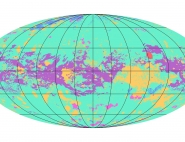Scientific Results obtained with PWA-HASI experiment
The PWA-HASI experiment of the Huygens probe on Titan revealed an unexpected atmospheric conductivity, an atypical Schumann resonance and an ocean of ammonia water hidden under some 45 km of ice
After more than four years of in-depth analysis of the data sent back by the Huygens probe, which landed on Titan on 14 January 2005, the major discoveries were obtained on the basis of low frequency wave and atmospheric conductivity measurements carried out using the "Plasma Waves and Altimetry" (PWA) experiment, a subsystem of "Huygens Atmospheric Structure Instrument" (HASI). The atmospheric conductivity was measured with excellent precision at below 100 km of altitude through different active experiments: via a Relaxation Probe alternating positively and negatively charged particles, and by the Mutual Impedance technique for the electrons. The latter experiment also measured the conductivity of the ground for over 2 hours after landing. The low frequency wave spectra captured by an electronic antenna and calculated on board were transmitted to Earth in two bands, from 6 to 96 Hz and from 180 to 11340 Hz.
The most surprising result concerning the atmospheric conductivity was the discovery at 62 km of altitude of a narrow ionised layer of around 25 km in thickness, unexpected at such a low altitude. The models did indeed predict the existence of such a layer at a much higher altitude, produced by high energy radiations that are basically galactic in origin. The misalignment with the existing models before the Cassini-Huygens is interpreted as an underestimation of the effectiveness of the ionisation and aerosol recombination processes, as well as their distribution by altitude in Titan's troposphere. The PWA results will make it possible to readjust the theoretical models in question.
As for waves, the most exciting phenomenon observed throughout almost the entire descent up until landing relates to a Schumann-type resonance trapped in the atmospheric cavity. Such a resonance is known only on Earth for being released by storm lightning and it had long been considered that its existence on other planets would make it possible to reveal the presence of both storm activity and a conductive ground. Although no storm activity has been detected on Titan to date, it was immediately established that the wave observed could easily be the second spherical harmonic of Titan's cavity, around 36 Hz. Moreover, hundreds of kA transported by the overall electrical circuit produced in Titan's ionosphere, generated by electrodynamics interaction of the plasma fluxes of Saturn's magnetosphere, might provide a small fraction (2%) of the total available power (thousands of Megawatts) necessary to feed this type of atypical Schumann resonance.
New developments of theoretical models and an enlarged interpretation of this data, in the framework of a generalised theory of Schumann resonance, make it possible to set limits for the properties of the cavity in question. These limits relate first of all to the conductivity of the neutral atmosphere, from the surface up to ionospheric altitudes of several hundred km, which are now accessible for probing from above by the Cassini orbiter. Last, but by no means least, strong limits can be set for the thickness and conductivity of the ice crust visible on the surface. These limits arise directly from the fact that the amplitude of the horizontal component of the electrical field of the signal shows a non-null residual value close to the ground. This necessarily implies the presence under the surface of a reflective medium and perfect conductor, on which this field should cancel out. This condition, together with the theoretical considerations on Titan's evolution and that of other ice moon such as those of Jupiter, Ganymede and Callisto, from their accretion to the modern day, leads us to the conclusion that the underground conductive surface is probably no more than the primordial ocean of ammonia water, currently confined below 45 (± 15) km of an ice crust. This result naturally leads to new limits on the processes governing the interactions of organic molecules with the liquid water. Such an oxygenated chemistry is in fact crucial to the search for prebiotic elements in Titan's interior.


